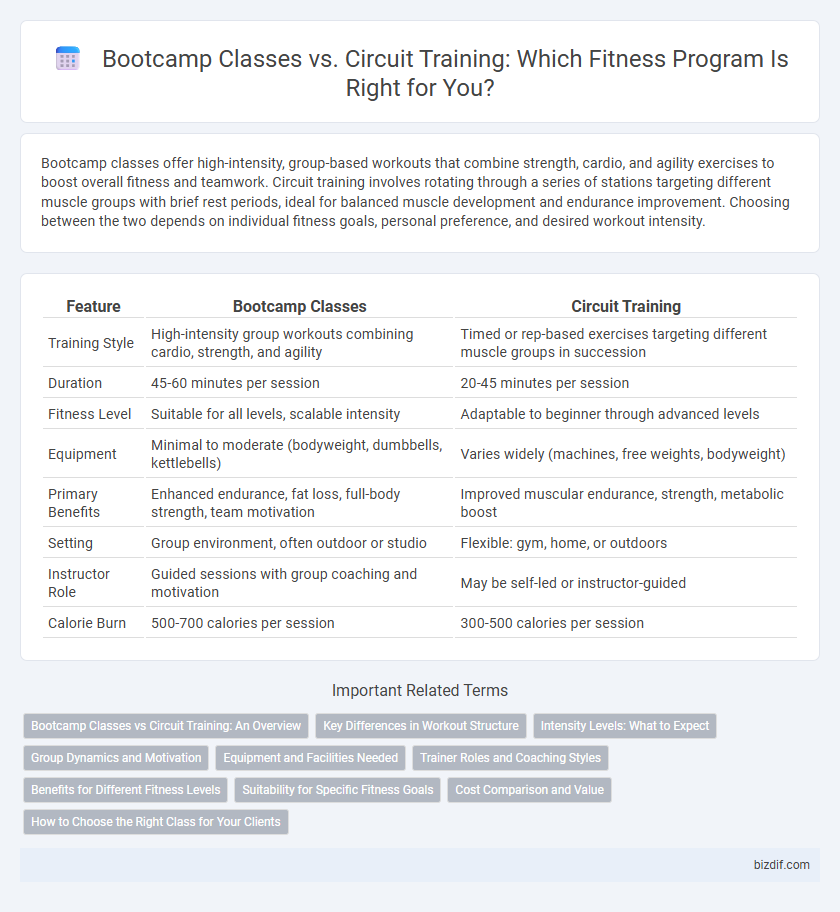Bootcamp classes offer high-intensity, group-based workouts that combine strength, cardio, and agility exercises to boost overall fitness and teamwork. Circuit training involves rotating through a series of stations targeting different muscle groups with brief rest periods, ideal for balanced muscle development and endurance improvement. Choosing between the two depends on individual fitness goals, personal preference, and desired workout intensity.
Table of Comparison
| Feature | Bootcamp Classes | Circuit Training |
|---|---|---|
| Training Style | High-intensity group workouts combining cardio, strength, and agility | Timed or rep-based exercises targeting different muscle groups in succession |
| Duration | 45-60 minutes per session | 20-45 minutes per session |
| Fitness Level | Suitable for all levels, scalable intensity | Adaptable to beginner through advanced levels |
| Equipment | Minimal to moderate (bodyweight, dumbbells, kettlebells) | Varies widely (machines, free weights, bodyweight) |
| Primary Benefits | Enhanced endurance, fat loss, full-body strength, team motivation | Improved muscular endurance, strength, metabolic boost |
| Setting | Group environment, often outdoor or studio | Flexible: gym, home, or outdoors |
| Instructor Role | Guided sessions with group coaching and motivation | May be self-led or instructor-guided |
| Calorie Burn | 500-700 calories per session | 300-500 calories per session |
Bootcamp Classes vs Circuit Training: An Overview
Bootcamp classes typically combine high-intensity interval training (HIIT) with strength and cardio exercises in a structured group setting, promoting overall endurance and muscle toning. Circuit training involves a series of different exercises performed in rotation with minimal rest, targeting various muscle groups to improve strength and cardiovascular fitness. Both methods enhance calorie burn and muscular endurance but differ in workout pacing and exercise variety.
Key Differences in Workout Structure
Bootcamp classes feature high-intensity, full-body workouts often conducted outdoors in group settings, emphasizing cardiovascular endurance and strength through varied functional exercises. Circuit training involves rotating through a series of targeted exercises with minimal rest, focusing on specific muscle groups and designed to improve muscular strength and endurance efficiently. Bootcamp workouts typically integrate dynamic, team-based challenges, whereas circuit training centers on structured, timed intervals for each station.
Intensity Levels: What to Expect
Bootcamp classes deliver high-intensity workouts incorporating strength, cardio, and agility exercises designed to push endurance and build muscle rapidly. Circuit training offers varying intensity levels tailored to individual fitness, cycling through stations targeting different muscle groups with brief rest periods. Expect bootcamp sessions to demand sustained high effort, while circuit training provides customizable intensity for balanced cardiovascular and strength conditioning.
Group Dynamics and Motivation
Bootcamp classes leverage high-energy group dynamics that foster camaraderie and boost motivation through collective challenges and encouragement. Circuit training offers a structured format where participants rotate through individual exercise stations, promoting self-paced progress but less social interaction. Group cohesion in bootcamp settings enhances accountability and sustained engagement, leading to improved fitness outcomes.
Equipment and Facilities Needed
Bootcamp classes typically require minimal equipment, using bodyweight exercises, resistance bands, and occasionally free weights, making them flexible for outdoor or park settings. Circuit training often involves a variety of machines, dumbbells, kettlebells, and specialized gym equipment, necessitating access to a well-equipped fitness facility. The choice between the two depends on the availability of suitable space and equipment, with bootcamp classes favoring portability and circuit training relying on diverse gear.
Trainer Roles and Coaching Styles
Bootcamp classes feature trainers who adopt a motivating, high-energy coaching style that fosters group cohesion and endurance, often leading participants through intense, varied exercises with real-time encouragement. In circuit training, trainers focus more on individual technique and pacing, providing personalized feedback to ensure proper form and optimize performance across different stations. Both approaches require trainers to balance instruction and motivation, but bootcamp instructors emphasize collective momentum while circuit trainers tailor coaching to individual needs.
Benefits for Different Fitness Levels
Bootcamp classes offer a structured, high-intensity workout designed to improve strength and cardiovascular endurance, making them ideal for individuals seeking a challenging group environment. Circuit training provides customizable stations that target various muscle groups with adjustable intensity, accommodating beginners and advanced participants alike. Both formats enhance overall fitness, but bootcamp classes emphasize collective motivation, while circuit training supports personalized progression for different fitness levels.
Suitability for Specific Fitness Goals
Bootcamp classes are ideal for individuals aiming to improve overall cardiovascular endurance and muscular strength through high-intensity, full-body workouts that incorporate varied exercises and team-based motivation. Circuit training suits those targeting muscle toning and endurance by cycling through a series of exercises with minimal rest, allowing focused muscle group development. Choosing between bootcamp and circuit training depends on whether the goal prioritizes explosive, varied intensity or consistent, targeted muscular conditioning.
Cost Comparison and Value
Bootcamp classes typically offer structured group sessions with professional trainers, often costing between $15 to $40 per class, reflecting the higher value of guided instruction and community motivation. Circuit training, usually available in gyms at no extra charge or minimal fees, allows for more flexible schedules but may lack personalized coaching, impacting overall effectiveness. Evaluating cost versus value depends on individual goals, with bootcamp classes providing more comprehensive support while circuit training offers affordability and convenience.
How to Choose the Right Class for Your Clients
Bootcamp classes emphasize high-intensity interval training with a mix of cardio, strength, and bodyweight exercises designed for group motivation and quick calorie burn. Circuit training involves rotating through a series of targeted strength or endurance exercises with minimal rest to promote muscular endurance and functional fitness. Selecting the right class depends on clients' fitness goals, whether they seek full-body metabolic conditioning with social engagement or focused muscle toning and endurance development through structured exercise stations.
Bootcamp Classes vs Circuit Training Infographic

 bizdif.com
bizdif.com